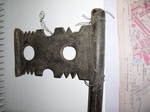I haven't actually seen the records but the Guildhall Library, London holds constitutional records for
- Worshipful Company of Weavers dating back to 1155
- Haberdashers Company dating back to 1446
- Hatmakers/ Hatters Company from 1501 (they joined the Haberdashers in 1511)
- Worshipful Company of Woolmen dating back to 1549
- Worshipful Company of Feltmakers from 1667
Livery companies evolved from the medieval guilds, religious foundations or fraternities of the City of London. These were religious and social in origin, but many also acquired an economic function by forming links with and eventually monopolising a particular craft or trade in the City. They became known as livery companies because of the distinguishing special costumes, or livery, worn by some or all of their members. http://www.history.ac.uk/gh/18ii.htm
The Worshipful Company of Feltmakers of London is still in existence and you can link to their history page http://www.feltmakers.co.uk/content/view/12/26/ to read their story to present day. I include quotes from the web site about their early history here
"The first known reference to Feltmakers as a distinct craft association is in London in 1180, although it is not known how long this lasted. In 1269 the Cappers became officially established. Hurers made shaggy and bristly caps at that time and in 1311 the Hatters are found carrying out an examination of hats at the Guildhall. Faced with the need to combat imports, obey the new Act of 1488 restricting sales prices and enforce the ordinances controlling the trade, the Hurers and the Cappers amalgamated with the Hatters and then merged with the powerful Haberdashers in 1502. Many of the feltmakers were already members of the Haberdashers and, as the Haberdashers controlled the retail outlets and the raw materials, this unification of the hatting trade, no doubt, seemed a sensible step. The Feltmakers were the only group to survive in name and became synonymous with hatters and is today the Livery Company of the hatters.In the middle of the 16th century discord developed between the Feltmakers and the Haberdashers from whom they were forced to buy their raw material of wool in ‘sacks unseen’. This led to much unrest and in 1583 they petitioned Queen Elizabeth I for their own Charter... One of the historical stories of the Feltmakers refers to Queen Elizabeth I who, on her journey to Tilbury in 1588 (at the time of the destruction of the Spanish Armada), was passing down Holborn Hill when she was met by a cheering crowd of well-dressed men wearing polished beaver hats; these were the hatters from Blackfriars and Southwark, the then centre of the hatting industry in London. It is reported that Her Majesty, much struck by their lusty demonstration of loyalty as well as their appearance, enquired who “these gentlemen were?”. On being told they were journeymen hatters, she replied “then such journeymen must be gentlemen”. The description stayed and journeymen hatters were referred to as “the gentlemen” until well after the First World War."




No comments:
Post a Comment